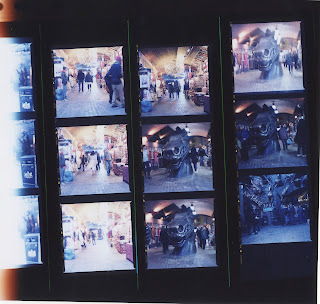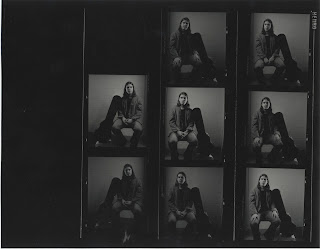The Object
Our first unit given was one called Object and Body, beginning with the object. The task set was to create a still life piece, with a theme centralised on a current issue or topic that you (the photographer) feels passionately about.
The topic I chose to tackle was 'consumerism', the definition of this being: "the preoccupation of society with consumer goods". My first item of research on this subject was a documentary called ‘Objectified’, this was a documentary based on the nature of a products design and manufacture, approaching mainly from a product designers point of view. There was one quote in this documentary however that stuck in my mind, which was: “Make what was now, look like then, so that people want our now”. This made me focus on the corporate backing to consumerism, and that we consume goods at a habitually alarming rate, to the extent when the purchasing of these goods loses all meaning.
After a tutorial, it was brought to my attention that I was crossing into two areas of consumerism, and so I chose to look less at the consumer society as a whole, and more of a statement about our self identity with these products, or rather lack thereof.
I was unclear of my visual style for this piece, until I saw a series of photographs by Danny Treacy called “Them”, which was a series of outfits constructed from strangers clothing.
I took this and decided to use fashion and clothing as my signifier for the consumerist products, as fashion is one of the most prominent and ever changing aspects of consumerism.
Next I looked at the nature of fashion, and decided that a mannequin would represent my consumer, as I am looking at the idea of meaningless or ‘soulless’ behind consumerism, a life size doll would be perfect to show the facade of consumerism.
I lastly needed a reinforcing symbol to the idea of ‘soulless’ and also something to make the mannequin replicate a human more prominently, so I chose an empty mirror frame, as it is a common habit to check oneself in the mirror, but adhering to old folklore, the lack of a reflection signifies the absence of a soul.
Environment
Alongside our Object and Body unit, we were given a unit called The Environment. In this unit we had to create a pastiche to one of three choices, and next to create three of our own images based on our own conceptual approach to representing landscape.
Our lectures began by looking at the birth of Romanticism in landscape paintings, and then in early landscape photography such Ansel Adams’ work on the American landscape.
As we looked at the Romantic movement, I began remembering what I had learnt of the Romantic movement in Poetry in my English A level, and this reminded me of poets like Wordsworth and Blake, but most predominantly, the work of John Claire. Who’s work was heavily influenced by England’s Agricultural Revolution.
This revolution was described by historian Mark Overton as “The shift to Capitalism in the agricultural world.” The main part of this revolution meant that all land had to be owned, and was no longer free.
I took this and began exploring this idea of an imprisoned land, or quarantine, something wasted as it is unused yet denied to us.
After a tutorial session where I displayed a test shot depicting a broken fence lying on a field, I was advised to pulled back a little and to show these vast denied landscapes more clearly.
I was also recommended to look at John Darwell’s work, ‘Dark Days’.
Looking at his use of the fence as a barrier between the viewer and the land, I decided to adopt this visual concept, but to elaborate the idea of the barrier into something far more domineering and overbearing, so I utilised low angle shots to over emphasise these barriers around the land.
I focused on high contrasts, and giving the fences far more focus in the foreground, but so that you could still make out what the fences blocked, but it has lost it’s detail and life along with it’s freedom.
For my pastiche I chose Robert Adams' 'On Signal Hill'.
Doing my best to replicate this shot, I chose a location on the edge of a hill, in Gillingham overlooking Chatham, so that I had a populated area behind my trees. Unfortunately I could not find a location with actual trees present and an appropriate view, so I actually used a 3 foot high plant shot up close to replicate the trees, and then appropriately angled my camera to proportion my sky, city, and foreground as close to Adam's as possible.
I chose a high aperture of F32 to make sure I maintained focus as much as possible in the foreground and background, and I exposed for the urban area at 1/2 a second to silhouette my foreground. I shot this at roughly 6a.m. in order to use the morning mist to replicate the fog hovering above Los Angeles.
Environment - The City
For our second task in our Environment unit, we are asked to investigate an element of the urban space that most interests us, be it political, metaphorical etc.
As I began my project on the urban environment, I at first found it quite hard to come up with a solid idea, or element of the urban space, that I wished to capture. So I began first by looking through visual sources, in search of inspiration.
My visual reference and idea eventually came from Ridley Scott's movie 'Blade Runner'.
I chose this as my visual reference, not for this exact shot as such, or in fact the story of the film, but more the city, and world it is set in. I chose this because I found that from afar most cities look very similar, a large cluster of tall objects, which applies to cities of the past, present, and future ideas of the city. The reason Blade Runner stood out to me, was the street level scenes, and if you watch documentaries behind it's creation, the city street is a complete cultural mismatch, due to globalisation every culture in the world is crammed together, and they all move around one another like there is no difference between them at all, there is even a language called 'city speak' in the film which is a blend of multiple language from Europe and Asia.
When I see these scenes I very much see many parts of London, a mismatch if you will, where the binary opposites of culture sit next to each other as one. One could argue that this creates a loss of value in these cultures, as the abnormal becomes commonplace, however what I see in this is simply acceptance.The city holds a taster of the rest of the world if you will, from this cut and paste element from many different cultures.
Looking through my contact sheets, I had to make a careful selection process in terms of what displayed the best oddities, and displayed my idea of the mismatch. I also had a lot of trouble with camera shake in my contact sheets, and had to go back on a number of occasions to reshoot because of this. I wanted a handheld feel from my photographs, to make them more involved in this market area, but due to the low light in the markets, it proved very difficult. Unfortunately I had a couple of shots I would have preferred to use as my final prints, if it where not for my problems with motion blurring, I would have also liked to have worked with film that yielded far more saturation in my colours, simply to make everything stand out more vividly and seem less 'real' if you will.
The Body
For our unit on 'The Body', we where asked to find a person that is unknown to us, and then to create a portrait of them. For my model I chose a local blues guitarist and singer named Liam Lynott, I chose him as he plays at many pubs I go to, and I have always been impressed by his set. The main reason he intrigued me, is not just his musical talent, but his style, he is a blues guitarist, yet he gets sandwiched between 'pop rock' bands. He always simply got up and played his set, regardless of the crowd, he acts almost as if we're not there, he simply plays. There is a simplicity and a purity that I wished to capture in that, he never shows a care for the crowd or popularity, he simply plays, he is a musician, a musician plays music, and that seems to be the only factors he cares for.
When researching other artists, Arnold Newman stood out to me, as I was fascinated by his 'Stravinsky'.
After looking into Newman's 'Stravinsky', I got out his book and viewed many of his portraits, both his lighting and his method of tailoring his sets around his models' proffesions and personalities was a concept I very much wanted to utilise. My model, as stated seemed to simply be a musician, or that was all he would reveal; Newman himself stated in his book on portraits that he is"convinced that any photographic attempt to show the complete man is nonsense,to an extent.We can only show, as best we can, what the outer man reveals." So I tailored my set to be simplistic and ambiguous as to where it could be, I set up my lighting, but left the brick wall blank, so that it may be, a studio, a venue, or a street in which my model is playing, it is an ambiguous and technically irrelevant factor to my model, so long as he is playing the venue need not exist.
At first I tried to mimic Newman's piano silhouette, using my models guitar case in it's stead, however after shooting this and reflecting upon the set up, the guitar was too small and object to effectively place in frame, but also the meaning behind the shoot did not match my model. So I combined my set up inspired by Arnold Newman, with a method from Phillip Lorca Dicorcia, who photographed commuters, but without their knowledge, to capture them without bias. I took this idea, and simply asked my model to play a set piece, as though he where busking, and after a while, he forgot his surroundings, as I intended the venue became irrelevant to him, and he simply played. I shot as he played, in an attempt to capture this simplistic honesty, about his music.
Pastiche
For my Pastiche I am using Brassai's "Paris After Dark No.27"
Brassai's visual style is very much in the Film Noir styling, utilising night time shots and the man made lighting in order to create this idea of mystery within the lights and shadows.
This shot was taken on 400ISO Ilford Black and White Film, on a Broncia SQ-B, with an Aperture of F9 and a 12sec Shutter Speed.
Looking at the alleyway I found it perfect for my Pastiche as it had a cobblestone paving, with merely a few scant sources of light, the main of which being an old victorian style lamp. I found this location mimicked Brassai's 'Paris After Dark' quite effectively in framing, light sources and also in architecture, as it quite an enclosed alleyway, there is no real hint of a modern world in sight.
















No comments:
Post a Comment